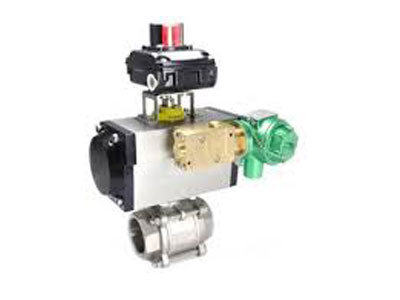What Is A Pneumatic Valve?
Key Takeaway
A pneumatic valve is a device used to control the flow of compressed air or gases within a pneumatic system. It helps direct, block, or regulate air movement, enabling the operation of machines like actuators and tools. By opening or closing specific pathways, pneumatic valves manage how air flows between components, ensuring systems function efficiently.
These valves are essential for tasks such as activating cylinders, controlling pressure, and switching between different air paths. Pneumatic valves work by moving a spool or actuator inside the valve to change the air’s direction. Types of pneumatic valves include manual, solenoid, mechanical, and air-piloted, each serving unique purposes in applications ranging from factory automation to train door control systems.
Key Components of Pneumatic Valves
Pneumatic valves comprise several essential components, each contributing to their functionality. The body serves as the primary housing, typically crafted from durable materials like brass or stainless steel, ensuring longevity. The ports act as entry and exit points for the medium, facilitating flow management.
Inside, the seals and spools work in tandem to control flow direction, while the actuator powers the mechanism. The actuator, often air-powered, translates energy into motion, enabling the valve to open, close, or modulate flow.
For precise operation, springs and pilot mechanisms play a key role. Springs provide resistance, maintaining balance, while pilot mechanisms guide operations in advanced systems. Together, these components ensure efficient, smooth valve performance.
Maintenance of these components is crucial. Regular cleaning, inspection, and lubrication can significantly extend the lifespan and efficiency of pneumatic valves.

Types of Pneumatic Valves and Their Functions
Pneumatic valves come in various types, each designed for specific purposes:
1. Directional Control Valves: Manage the flow direction of air or gas. Common in automation, they dictate where and how the medium flows.
2. Pressure Control Valves: Maintain optimal pressure levels within the system, preventing overloads or inefficiencies.
3. Flow Control Valves: Regulate the volume of medium flowing through a system, ensuring consistent performance.
4. Shut-Off Valves: Provide complete flow stoppage, essential for safety and maintenance.
Each type of valve serves a unique function, ensuring pneumatic systems operate seamlessly. For instance, directional control valves are pivotal in assembly lines, while pressure control valves safeguard sensitive machinery. Choosing the right valve depends on the system’s specific needs and operational demands.
Applications of Pneumatic Valves in Industry
Pneumatic valves are a backbone of many industries due to their adaptability and efficiency. In manufacturing, they automate production lines, enhancing speed and precision. They control robotic arms, conveyor belts, and assembly machinery.
In the healthcare sector, these valves regulate air pressure in ventilators and medical gas systems, ensuring patient safety. Similarly, in automotive manufacturing, they facilitate painting systems, tire inflation, and other automated processes.
The energy sector also benefits from pneumatic valves, particularly in controlling fluid flow in pipelines and managing power plant systems. Whether it’s oil, gas, or renewable energy, these valves ensure operational efficiency.
From packaging industries to wastewater management, pneumatic valves prove their versatility. Their ability to perform under various conditions makes them indispensable across industrial applications.
Advantages of Pneumatic Valves Over Other Valve Types
Pneumatic valves offer several advantages, making them superior in many scenarios:
1. Energy Efficiency: They rely on compressed air, reducing energy consumption compared to electric valves.
2. Reliability: With fewer moving parts, they have a lower failure rate, ensuring consistent performance.
3. Safety: Pneumatic systems are safer in hazardous environments as they don’t produce sparks, unlike electric systems.
4. Cost-Effective: Installation and operational costs are lower, especially in industries requiring extensive valve systems.
Their quick response time and precise control capabilities further enhance their appeal. While electric and hydraulic valves have their place, pneumatic valves dominate when simplicity, reliability, and cost-efficiency are priorities.
Maintenance Tips for Prolonged Valve Life
Proper maintenance is key to maximizing the efficiency and lifespan of pneumatic valves. Here are some essential tips:
Regular Cleaning: Dust and debris can hinder valve performance. Clean external surfaces and internal components regularly.
Inspect Seals and Gaskets: Worn seals can lead to leaks. Inspect and replace them during routine maintenance.
Lubrication: Proper lubrication minimizes friction, ensuring smooth operation and reducing wear and tear.
Check Air Quality: Contaminated air can damage valves. Use filters to maintain clean, dry air in the system.
Perform Routine Testing: Regularly test valve functionality to identify and address potential issues before they escalate.
By adhering to these maintenance practices, industries can ensure their pneumatic systems operate efficiently for years, reducing downtime and repair costs.
Conclusion
Pneumatic valves are the unsung heroes of industrial automation, offering precision, reliability, and efficiency. From managing complex machinery to ensuring safety in critical processes, their role is indispensable.
With proper maintenance, these valves can deliver unmatched performance, helping industries achieve their operational goals seamlessly. Investing in high-quality pneumatic valves and adhering to routine care will ensure long-term benefits, keeping systems running smoothly.

